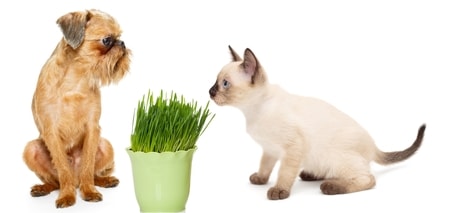
Dogs eating cat grass: is this normal behavior? Is it OK for my canine? Here’s what the experts say:
- Cat grass which is free of toxic chemicals is fine for dogs to eat.
- Nibbling cat grass could help your dog stay healthier.
- Eating too much cat grass could be a symptom that needs to be checked out by your vet.
You find your dog nibbling away at your indoor or outdoor cat grass. Your first thought is, “Strange…canines are carnivores (meat eaters), right? Is this behavior OK?”
Well, dogs are not strictly carnivores. Modern domestic dogs benefit from a diet which includes grains, fruits, and vegetables.
These ingredients are not just to fill them up. They can give your dog essential vitamins, minerals, and fiber.
So, let’s see where cat grass can fit into your dog’s balanced diet.
1. Cat grass is ok for dogs as long as it is pesticide- and herbicide-free.

Research shows that these chemicals are harmful to dogs.
One study found that lawn treatment chemicals were found in the urine of the majority of dogs tested.
Scientists suspect that these chemicals can have negative effects on a dog’s health, although more studies need to be done to confirm this.
As a result, it is recommended to grow your dog’s cat grass inside.
You can buy a variety of cat grass seeds and kits. Your local garden center will probably offer some, and there is always online.
In general, cat grass remains edible for about 2-3 weeks after sprouting.
Once it starts looking unappealing, it is best to throw it away and start again.
The reason for this is the many pests which also like cat grass.
You can read my expert article on cat grass bugs here.
Your cat grass seed packet or growing kit will include full instructions, but here’s an overview of ‘how-to’.
Step 1: Use fresh potting soil
To keep pests at a minimum, don’t economize. Use new potting soil.
Sow your seeds about ¼ inch deep (about 0.6 cm).
Step 2: Keep soil moist
Don’t overwater. Damp soil is enough.
When you see the sprouts, you should actually decrease the amount of water you use.
Step 3: Place the container to get natural light and air
Some bright, natural daylight is needed to successfully grow cat grass.
It is also best to make sure the spot is well ventilated.
Step 4: ‘Harvest’ 10-14 days after sprouting
You should see young sprouts between 3-7 days after sowing.
When the sprouts have reached roughly 4 inches high (roughly 10 cm), they are mature enough for your dog to eat.
The sprouts will keep fresh for several weeks.
Once they begin to turn color or wilt, throw them away and begin again.
Top Cat Grass Tip
Once your container of cat grass has reached ‘eating height,’ start your next container.
In that way, your canine will have an almost continuous supply of nutritious grass to eat.
2. Toxic-free cat grass appears to be a natural food for dogs.

the number of domestic dogs who regularly eat cat grass and other plants, it is surprising how little research there is on this topic.
Studies shown on wild animals show that up to 74% of wolves and cougars have plant remains in their stool (poop).
So, one scientific theory is that eating cat grass and other plants is part of the canine’s wild heritage…in other words, a part of its DNA.
Why is that?
Wild animals are always at the risk of getting internal parasites such as nematodes (roundworms).

As the plant material moves through the animal’s intestines, it tends to wrap around any worms living there.
The result is that the worms come out in the stool, and the intestinal tract is cleaned out.
3. What if the cat grass makes my dog vomit (throw up)?
Myth: Dogs eat cat grass because they are sick and want to vomit to help themselves get better.
Truth: A scientific study showed that there is no evidence for this statement.
Having said that…
If you see that your dog gets into a cycle (a habit) of eating cat grass and vomiting, take your pet to the vet as soon as possible to make sure that all is well.
4. Perhaps my dog is eating cat grass because it has a nutritional deficiency?

PICA
When a human or animal eats things which aren’t what we usually think of as food, we say that the organism has ‘pica’.
Pica could be a result of curiosity, especially in young humans and animals.
We also have to be aware of cultural bias. Some of the things we may not consider to be ‘food’ could be delicacies for others.
Once in a while, pica is a symptom of a nutritional deficiency.
If in doubt, take your pet to the vet for some blood tests to rule this out.
5. Watch out that the cat grass does not become too much of a good thing.
You are probably giving your canine a balanced diet by choosing a quality dog food…and your dog is not a cow after all.
One thing you should not see is your dog eating large amounts of cat grass on a regular basis.
If your canine is eating more cat grass than he or she usually does, it is time to take your pet to your veterinarian for a check-up.
Your vet will do a thorough physical exam.
They will also examine your dog’s stool and blood.
This will show if there is inflammation, some gastrointestinal disease, or another illness which is causing your dog’s unusual behavior.
Writer: Lisa Aharon

Sources
https://pets.webmd.com/dogs/why-do-dogs-eat-grass#1
https://www.akc.org/expert-advice/nutrition/best-dog-food-choosing-whats-right-for-your-dog/
https://www.bellrockgrowers.com/product/live-grasses/
https://www.hillspet.com/dog-care/behavior-appearance/why-do-dogs-eat-grass
https://www.lifegate.com/people/lifestyle/herbicides-harm-dogs
https://www.petmd.com/cat/care/evr_ct_how-to-grow-cat-grass
https://www.petmd.com/dog/wellness/evr_dg_eating_grass
https://www.psychologytoday.com/intl/blog/canine-corner/201412/why-dogs-eat-grass-myth-debunked
https://www.quora.com/Is-it-safe-for-dogs-to-eat-cat-grass
https://www.researchgate.net/publication/288656215_Why_do_dogs_and_cats_eat_grass
https://www.sciencedirect.com/science/article/pii/S0048969713003100
https://www.southbostonanimalhospital.com/blog/if-your-dog-is-eating-grass